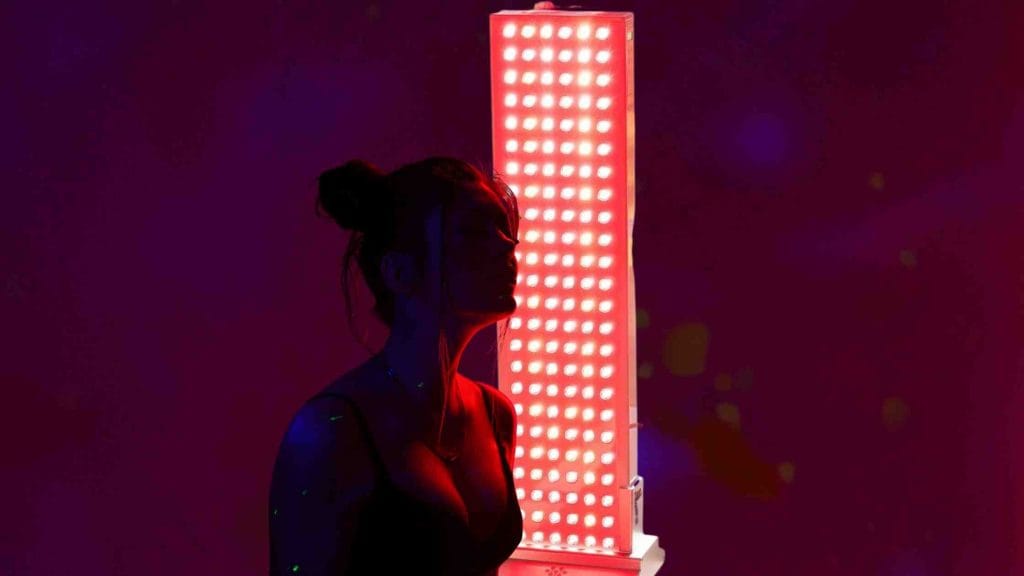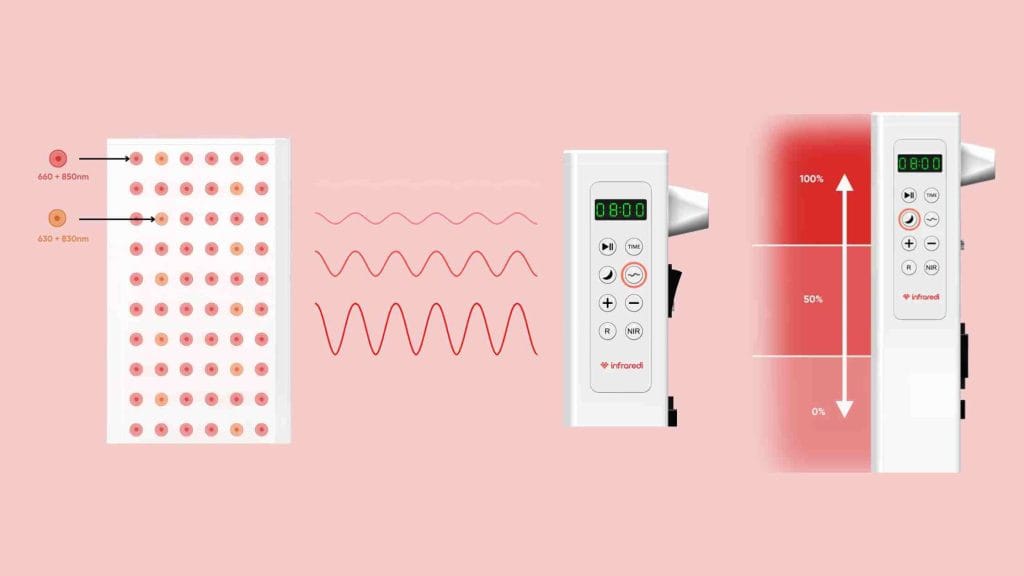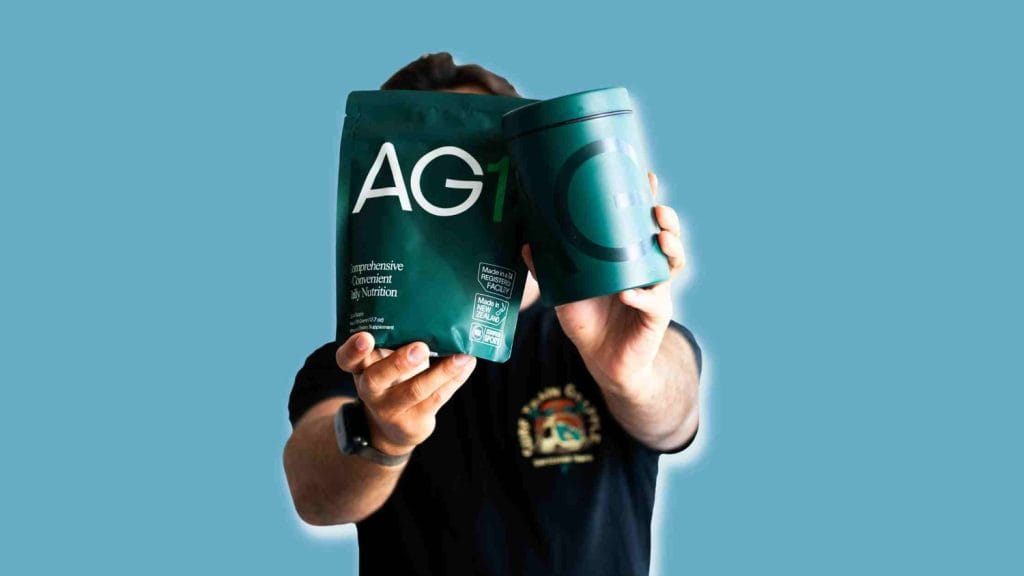Infraredi Pro Max Red Light Therapy Panel Review
We include links to products we think are useful for our readers. If you click and buy a product through one of the affiliate links on this page, we may earn a small commission.

Infraredi Red Light Panel Review
Key Takeaways
The Infraredi Pro Max incorporates Multiwave Technology, offering a blend of different light spectrums for comprehensive wellness benefits.
It features 6 Watt Dual Lens LEDs for focused and potent light therapy sessions.
Offers customizable treatments with Pulsing+ and Dimming+ Modes.
Provides a flexible Red & NIR Light selection for targeted therapy.
Priced at $1499AUD, the Infraredi Pro Max has great value with a 3-year warranty and a 60-day risk-free trial.
Red light therapy is one of the fastest growing biohacking and wellness tools right now.
Red light and infrared light can be used to treat various skin issues and can help boost mitochondrial function, which are our energy powerhouses.
We’ve been testing out red light panels for years now, in the name of providing the optimal environment for cells to thrive and the body to heal.
While the red light therapy market continues to explode, there are always standouts in a booming industry – Infraredi is one of those.
In this article, I will illuminate the Infraredi Pro Max red light panel with a detailed summary of why I think it should be one of the top picks when considering red light therapy devices to buy online.
Infraredi Pro Max Red Light Therapy Panel
Price: $1499AUD to $1649AUD
LED Count: 150
Power: 900W
Shipping: Free
Warranty: 3 years
Use code RECOVERYGURU for 10% off
How Does Red Light Therapy Work?
Before jumping into the Infraredi review, it’s worth fleshing out how red light therapy works as a wellness tool that has proven benefits for everything from eye health to hair growth to skin and wound healing.
With these red light panels, the good ones offer both red light and infrared light treatment, with the ability to combine the two.
So, light therapy using red and infrared light involves using specific wavelengths of light to target the skin and body.
Red light therapy utilises visible red light, while infrared light therapy uses invisible infrared light. Both types of light are non-invasive and are thought to have various benefits for the body.
Here’s how it works in lamens terms:
Red Light Therapy
Red light typically falls within the range of 620 to 700 nanometers on the light spectrum.
When applied to the skin, it penetrates the surface and is absorbed by the cells. It stimulates the mitochondria, which are like the powerhouses of our cells.
This stimulation boosts the production of adenosine triphosphate (ATP), a molecule that carries energy within the cells. Essentially, this energy boost aids in the cell’s repair and rejuvenation process.
Infrared Light Therapy
Infrared light falls beyond the visible light spectrum and isn’t visible to the human eye. It typically ranges from about 700 nanometers to 1 millimeter. Infrared light can penetrate deeper into the body compared to red light. It generates heat and can penetrate into tissues, muscles, and even bones.
The heat produced can increase blood flow and promote healing, providing relief for muscle soreness, joint pain, and inflammation.
Both red and infrared light therapies are used for various purposes and are said to offer numerous benefits:
Skin Health: Red light therapy is often used for skin treatments. It can help with issues like wrinkles, fine lines, and other signs of aging by stimulating collagen production and promoting skin cell regeneration. This may result in improved skin texture and tone.
Pain Relief and Inflammation: Infrared light therapy is commonly used to alleviate muscle soreness, joint pain, and inflammation. The heat generated by the infrared light helps increase blood circulation, which aids in the body’s natural healing processes.
Wound Healing: Both red and infrared light therapies have been used to promote faster healing of wounds, cuts, and injuries. By stimulating cellular energy and promoting circulation, these therapies may speed up the body’s natural healing mechanisms.
Mood Enhancement: Some research suggests that light therapy, especially exposure to certain wavelengths of light, can help improve mood and alleviate symptoms of conditions like seasonal affective disorder (SAD).
Why Infraredi?

The Infrared brand is ThereAt the core of the Infraredi Pro Max is its groundbreaking Multiwave Technology, integrating a combination of 630nm, 660nm, 830nm, and 850nm spectrum lights. This innovative technology takes a comprehensive approach to wellness, penetrating various skin layers to unlock a spectrum of health benefits by targeting different cellular levels.
The inclusion of 6 Watt Dual Lens LEDs amplifies the efficacy of light therapy, ensuring a more focused and potent treatment. This feature maximises the impact of each session, making them not just impactful but also time-efficient—an essential aspect in a busy daily routine.
The standout feature, the Pulsing+ Mode, allows for a level of customisation that I have not seen in any other red light panel or device. It offers users the ability to select the desired frequency, enabling fine-tuning of sessions to cater specifically to the body’s changing needs at different times.
Complementing this customisation is the Dimming+ Mode, allowing for the adjustment of light strength, ensuring a tailored and comfortable experience. This adaptability is crucial, especially as individual responses to therapy can vary, requiring a personalized approach to each session.
As an example, at night you may find that full strength is a little too intense, and dialling back the dimming settings will give you a more suitable night time red light therapy treatment.
The Red & NIR Light selection provides users with the flexibility to target specific areas or concerns, offering tailored treatments according to individual wellness goals. This customizable aspect adds significant value to the overall experience.
Priced at $1499, the Infraredi Pro Max Red Light Panel price is extremely reasonable considering its features and warranty. Compared to other red light panels available for half to full body coverage, like the Joov Solo red light for example, the Infraredi Pro Max is easily the best value.
The Joov Solo, which is a similar size and functionality, costs $1699USD plus shipping. The Infraredi Pro Max has free shipping and a superior warranty, at around $1200AUD cheaper price point.
No brainer if you ask me.
Not only that, the certification by the Therapeutic Goods Administration (TGA) in Australia underlines the Infraredi Red Light Panels’ commitment to stringent quality and safety standards. They also have one of the best warranties for a red light panel in the industry, at 3 years, plus a 60 day risk free trial policy which gives you the opportunity to try out the Infrared panels with low risk.
User Experience
The Infraredi Pro Max is on the upper end of the spectrum in terms of red light panel quality.
The overall experience of Infraredi red light panel was gold. The unit arrived within 2-3 days of order, with super simple instructions for use to get started with setup and adjusting controls.
One of the things I like most about the Infrared Pro Max is that is included the stand which gives you the option to have it standing upright. The Pro Max is definitely large enough to be used as a whole or full body panel, and I am about 175cm tall last time I checked.
Shop Infraredi with code RECOVERYGURU for discount
It also comes with a door hanging system that allows you to easily hang the red light panel off the back of a door, which hides the red light panel away nicely if space is limited.
The ease of use and functionality of the panel make it a massive standard in this crowded red light device space, with one of the most highly functional red light products I’ve seen, considering the dimming and pulsing functions.
The Infraredi red light panel is a tool that I have enjoyed incorporated into existing practices, known as habit stacking. I honestly love combining my morning breathwork and mediation practices with the Infraredi red light panel cranking out red and infrared light in combination.
The red light is super relaxing and offers a new level to the practice. I also like having the red light panel on while doing some light movement and yoga in the evening, it really fills the room with that rich, red, healing light.
Frequently Asked Questions
A red light therapy device offering a combination of red and infrared light for various wellness benefits is a powerful tool in the realm of non-invasive health and beauty treatments. Red light therapy, also known as low-level laser therapy (LLLT) or photobiomodulation, utilizes specific wavelengths of light to penetrate the skin and stimulate cellular activity. This stimulation can lead to a variety of positive outcomes, including enhanced skin health, reduced inflammation, and accelerated healing processes.
The combination of red and infrared light in such a device targets different layers of the skin and tissues. Red light, typically in the wavelength range of 630-660 nanometers, is absorbed by the skin and can help to improve skin tone and texture, reduce the appearance of fine lines and wrinkles, and promote collagen production. This makes it a popular choice for anti-aging treatments and overall skin rejuvenation. By boosting collagen, the skin becomes firmer and more elastic, contributing to a youthful appearance.
Infrared light, which has a longer wavelength (typically 810-850 nanometers), penetrates deeper into the body’s tissues. This deeper penetration allows it to reach muscles, joints, and even bones, providing benefits that go beyond the surface. Infrared light can help to reduce muscle pain and stiffness, improve joint health, and enhance overall circulation. This makes the device particularly beneficial for individuals with chronic pain conditions, athletes recovering from injuries, or anyone seeking to improve their physical performance and recovery.
One of the key wellness benefits of a red light therapy device is its ability to reduce inflammation. Inflammation is a common underlying factor in many chronic conditions, including arthritis, fibromyalgia, and even certain skin disorders like acne and psoriasis. By reducing inflammation, red and infrared light therapy can alleviate pain and discomfort, improve mobility, and enhance overall quality of life. This anti-inflammatory effect also contributes to faster healing and recovery from injuries and surgical procedures.
Includes Multiwave Technology with various spectrum lights, 6 Watt Dual Lens LEDs, Pulsing+ and Dimming+ Modes, and Red & NIR Light selection, this red light therapy device is at the forefront of advanced phototherapy solutions. The Multiwave Technology allows for the emission of different wavelengths of light, providing a comprehensive approach to light therapy that targets multiple layers of skin and tissues simultaneously. This technology ensures that users receive the full spectrum of therapeutic benefits, from surface-level skin rejuvenation to deeper muscle and joint recovery.
The incorporation of 6 Watt Dual Lens LEDs significantly enhances the device’s effectiveness. These high-powered LEDs deliver more light energy per session, ensuring that users experience faster and more pronounced results. The dual lens design also helps to focus and distribute the light evenly across the treatment area, maximizing the coverage and penetration of the light. This ensures that every part of the skin or muscle being treated receives an optimal dose of therapeutic light, enhancing the overall efficacy of the treatment.
Pulsing+ and Dimming+ Modes offer users customizable treatment options tailored to their specific needs and preferences. Pulsing+ Mode allows the device to emit light in pulses, which can enhance cellular stimulation and improve the therapeutic outcomes for certain conditions. This mode is particularly beneficial for promoting cellular repair and regeneration, as the pulsing light can increase cellular activity and ATP production more effectively than continuous light. Dimming+ Mode, on the other hand, allows users to adjust the intensity of the light, making the treatment more comfortable for sensitive areas or during longer sessions. This customization ensures that each user can optimize their treatment experience based on their individual tolerance and therapeutic goals.
The Red & NIR Light selection feature further enhances the versatility of the device. Users can choose between red light, near-infrared (NIR) light, or a combination of both, depending on their specific needs. Red light, with its shorter wavelengths, is ideal for surface-level treatments such as skin rejuvenation, collagen production, and reducing the appearance of fine lines and wrinkles. NIR light, with its longer wavelengths, penetrates deeper into the tissues, making it suitable for treating muscle pain, joint stiffness, and enhancing overall circulation. This ability to select and combine different types of light allows users to target specific issues more precisely and effectively.
The advanced features of this red light therapy device also contribute to its overall user-friendliness. The intuitive controls and clearly labeled settings make it easy for users to select their desired treatment modes and light types. This ensures that even those new to red light therapy can quickly and confidently use the device to its full potential. The combination of powerful technology and ease of use makes it accessible to a wide range of users, from professional athletes to individuals seeking general wellness benefits.
Priced at $1499AUD, it’s considered an excellent value compared to similar products like the Joov Solo.
Certified by the Therapeutic Goods Administration (TGA) in Australia, this red light therapy device meets stringent safety and efficacy standards, providing users with a high level of confidence in its therapeutic capabilities. The TGA certification is a testament to the device’s quality and reliability, as the TGA is known for its rigorous evaluation process, ensuring that medical devices meet comprehensive health and safety regulations. This certification not only validates the device’s effectiveness but also assures users that it has undergone thorough testing and meets the high standards required for therapeutic use.
The TGA certification also signifies that the device is backed by scientific evidence supporting its benefits. To obtain TGA approval, the manufacturer must provide substantial clinical data demonstrating the device’s safety and effectiveness for its intended use. This includes studies and trials that showcase the device’s ability to deliver measurable health benefits, such as reducing inflammation, alleviating pain, and improving skin health. For users, this means they can trust that the device is not only safe but also capable of providing real, clinically proven results.
Furthermore, being certified by the TGA enhances the device’s credibility in the global market. The TGA is recognized internationally for its stringent standards, and its certification is often viewed as a mark of excellence. This can be particularly reassuring for consumers who may be comparing different products and looking for one that stands out in terms of quality and regulatory approval. The TGA certification provides an added layer of assurance that the device is a top-tier option in the field of red light therapy.
For healthcare professionals and clinics, the TGA certification is especially significant. It allows them to confidently recommend or use the device as part of treatment plans, knowing that it complies with rigorous health regulations. This can be crucial for ensuring patient safety and achieving optimal therapeutic outcomes. The certification can also facilitate the integration of the device into clinical settings, where adherence to regulatory standards is mandatory.
In addition to safety and efficacy, TGA certification often involves assessments of the device’s manufacturing processes and quality control measures. This ensures that each unit produced meets consistent quality standards, minimizing the risk of defects or variations. For consumers, this means they can expect a high level of performance and durability from their device, contributing to long-term satisfaction and value.
Offers a 3-year warranty and a 60-day risk-free trial, this red light therapy device ensures peace of mind and customer satisfaction through robust support and a commitment to quality. The 3-year warranty stands as a testament to the manufacturer’s confidence in the device’s durability and performance. This extended warranty period covers any potential defects or malfunctions, providing users with assurance that their investment is protected for the long term. Should any issues arise, the warranty ensures that they will be addressed promptly and effectively, minimizing disruption to the user’s wellness routine.
The 60-day risk-free trial further underscores the manufacturer’s dedication to customer satisfaction. This trial period allows users to experience the full range of benefits that the red light therapy device offers without the pressure of an immediate commitment. During these 60 days, users can integrate the device into their daily routine and observe its impact on their skin health, muscle recovery, and overall well-being. This risk-free trial is especially beneficial for individuals new to red light therapy, as it provides ample time to understand how the device can meet their specific needs and goals.
The combination of a 3-year warranty and a 60-day risk-free trial demonstrates a strong commitment to product quality and customer care. It reflects the manufacturer’s confidence in the device’s construction and functionality, as well as their understanding of the importance of customer trust. By offering these assurances, the manufacturer not only stands behind the product but also empowers users to make informed decisions about their health and wellness investments. This level of support and transparency is rare in the market and significantly enhances the device’s appeal.
For potential buyers, the 60-day risk-free trial eliminates the hesitation often associated with purchasing health and wellness devices. It provides a window of opportunity to test the device’s features, assess its effectiveness, and determine whether it fits seamlessly into their lifestyle. If, for any reason, the device does not meet their expectations, the trial allows for a hassle-free return process, ensuring that customers are not financially burdened by a purchase that does not satisfy their needs.
The 3-year warranty also speaks to the longevity and reliability of the device. Knowing that the manufacturer offers extended coverage gives users confidence in the device’s long-term performance. This assurance is particularly valuable for those who plan to incorporate red light therapy into their regular self-care or recovery routines, as it guarantees that the device will remain a dependable tool for years to come. The warranty covers various aspects of the device, including any potential manufacturing defects or operational issues, ensuring comprehensive protection.
Additionally, these customer-centric policies highlight the manufacturer’s dedication to building lasting relationships with their clientele. By providing a generous warranty and trial period, they show that customer satisfaction is a top priority. This approach not only helps in retaining customers but also encourages word-of-mouth referrals and positive reviews, further strengthening the brand’s reputation in the market. Such policies can transform a one-time purchase into a long-term commitment to the brand, fostering loyalty and trust.
Red light therapy utilizes specific wavelengths of red and infrared light to harness the therapeutic benefits of light energy. These wavelengths, typically in the range of 630 to 850 nanometers, penetrate the skin’s surface and reach underlying tissues, where they interact with cellular structures. The primary mechanism of action involves stimulating the mitochondria, the powerhouse of cells, to produce more ATP (adenosine triphosphate). ATP is essential for cellular function and plays a crucial role in cellular repair and regeneration.
One of the key benefits of red light therapy is its ability to promote healing. By enhancing ATP production, red and infrared light accelerate the repair of damaged tissues and promote the formation of new capillaries. This can be particularly beneficial for individuals recovering from injuries, surgeries, or chronic conditions that involve tissue damage. The increased cellular activity also supports faster wound healing and reduces the overall recovery time.
In addition to promoting healing, red light therapy is effective in reducing inflammation. Inflammation is a natural response of the immune system to injury or infection, but chronic inflammation can contribute to various health problems, including pain and autoimmune disorders. Red and infrared light help to reduce inflammation by modulating immune response and decreasing the production of pro-inflammatory cytokines. This anti-inflammatory effect can alleviate pain, swelling, and discomfort associated with conditions like arthritis, tendonitis, and fibromyalgia.
Furthermore, red light therapy is renowned for its ability to improve skin health and appearance. The wavelengths of light used in therapy penetrate the skin’s layers, stimulating collagen and elastin production. Collagen is a protein that provides structure and elasticity to the skin, while elastin maintains skin firmness and suppleness. By increasing collagen and elastin synthesis, red light therapy helps to reduce the appearance of wrinkles, fine lines, and sagging skin. It also promotes cellular turnover, resulting in smoother, more radiant skin.
Another notable benefit of red light therapy is its role in enhancing circulation. Improved blood circulation delivers oxygen and nutrients to cells more efficiently, supporting overall cellular function and tissue repair. This enhanced circulation can benefit various bodily systems, including cardiovascular health and muscle recovery after exercise. Athletes and fitness enthusiasts often use red light therapy to accelerate muscle repair and reduce post-exercise soreness, enabling quicker recovery and improved performance.
Yes, red light therapy is widely recognized for its effectiveness in alleviating muscle soreness, joint pain, and reducing inflammation. Athletes, fitness enthusiasts, and individuals recovering from injuries often turn to red light therapy to accelerate their healing process and enhance recovery. The therapy works by penetrating the skin with specific wavelengths of light, typically in the red (630-660 nm) and near-infrared (810-850 nm) spectrums, which reach deep into tissues and cells.
One of the primary mechanisms through which red light therapy helps relieve muscle soreness and joint pain is by enhancing cellular metabolism and ATP production. ATP, or adenosine triphosphate, is the energy currency of cells and is crucial for cellular repair and regeneration. By stimulating ATP production in muscle cells and tissues, red light therapy promotes faster recovery from physical exertion, reducing the buildup of lactic acid and other metabolic by-products that contribute to soreness.
Moreover, red light therapy has been shown to reduce inflammation, a common underlying factor in both acute injuries and chronic conditions such as arthritis. Inflammation is the body’s natural response to injury or stress, characterized by swelling, pain, and heat. Red and near-infrared light wavelengths help to modulate inflammatory pathways by reducing the production of pro-inflammatory cytokines and promoting the release of anti-inflammatory mediators. This dual action helps to alleviate pain and swelling, allowing for improved mobility and comfort.
Another benefit of red light therapy in relieving muscle soreness and joint pain is its ability to enhance blood circulation. Improved circulation facilitates the delivery of oxygen and nutrients to muscles and joints, promoting faster healing and reducing stiffness. Enhanced blood flow also aids in the removal of metabolic waste products from tissues, which can further contribute to reducing soreness and promoting overall recovery.
Additionally, red light therapy is non-invasive and well-tolerated, making it a suitable option for individuals seeking natural pain relief without the side effects associated with medications or invasive procedures. The therapy is typically administered using light-emitting devices that can be applied directly to the affected area or used over larger muscle groups, depending on the treatment goals. Sessions are relatively short, typically lasting between 10 to 20 minutes, and can be performed in the comfort of one’s home or under the guidance of a healthcare provider.
The frequency of red light therapy sessions can vary depending on individual goals and the specific condition being treated. For optimal results, consistent use is typically recommended, often several times a week initially, especially when targeting specific health concerns like skin conditions, pain management, or recovery from injuries.
For skincare benefits such as reducing wrinkles, improving skin tone, and enhancing collagen production, frequent sessions—typically 3 to 5 times per week—are often recommended initially. This regimen helps to stimulate cellular activity and maximize the therapeutic effects of red and near-infrared light on the skin’s layers. Over time, as desired results are achieved, the frequency of sessions may be reduced to a maintenance level, such as 1 to 3 times per week, to sustain improvements.
Similarly, for addressing muscle soreness, joint pain, or inflammation, frequent sessions are beneficial to support recovery and alleviate discomfort. Athletes and individuals undergoing physical therapy may initially undergo red light therapy sessions several times per week to expedite healing and reduce pain. This approach helps to optimize the therapy’s anti-inflammatory effects and promote faster tissue repair, enabling quicker return to physical activities and sports.
It’s important to note that individual responses to red light therapy can vary, and the optimal frequency of sessions may be adjusted based on personal tolerance, treatment progress, and specific health goals. Some users may experience noticeable improvements after just a few sessions, while others may require longer periods of consistent use to achieve desired outcomes. Consulting with a healthcare provider or a qualified therapist can help determine the most appropriate treatment schedule tailored to individual needs and conditions.
Red light therapy is considered a safe and non-invasive treatment option with minimal side effects when used as directed. The therapy utilizes specific wavelengths of light, typically in the red and near-infrared spectrum, which penetrate the skin without causing damage to surrounding tissues or cells. This targeted approach minimizes the risk of adverse reactions commonly associated with more invasive treatments or medications.
In clinical studies and real-world applications, red light therapy has demonstrated a favorable safety profile, making it suitable for a wide range of individuals, including those with sensitive skin or underlying health conditions. However, like any therapeutic intervention, individual responses may vary, and some people may experience mild side effects such as temporary skin sensitivity, redness, or irritation, particularly during initial sessions. These effects are usually mild and transient, resolving shortly after treatment.
To minimize the risk of side effects and enhance comfort during red light therapy sessions, it’s essential to adhere to recommended guidelines regarding session duration, distance from the light source, and appropriate eye protection if applicable. Adjusting the intensity or duration of sessions based on individual tolerance levels can also help optimize the therapy’s benefits while minimizing potential discomfort.
For individuals with specific skin conditions or medical concerns, consulting with a healthcare provider or dermatologist before starting red light therapy is advisable. They can provide personalized recommendations, address any potential contraindications, and ensure that the therapy aligns with overall health goals and treatment plans.
Yes, red light therapy has shown promising benefits for improving skin texture, reducing signs of aging, and aiding in the treatment of various skin conditions. One of its key effects is stimulating collagen production, which is crucial for maintaining skin elasticity and firmness. Collagen is a protein that supports the structure of the skin, and as we age, its production naturally decreases, leading to the formation of wrinkles, fine lines, and sagging skin. By stimulating collagen synthesis through the activation of fibroblast cells in the skin’s dermis, red light therapy helps to restore skin elasticity and smooth out imperfections.
Furthermore, red light therapy promotes increased circulation and oxygenation in the skin, which can contribute to a more youthful appearance. Improved blood flow delivers essential nutrients and removes toxins, supporting overall skin health and vitality. This enhanced circulation also aids in reducing puffiness and promoting a radiant complexion, making the skin appear more refreshed and rejuvenated.
In addition to its anti-aging benefits, red light therapy is effective in treating acne and other skin conditions characterized by inflammation. The therapy’s anti-inflammatory properties help to reduce redness and swelling associated with acne lesions, while its antibacterial effects can target acne-causing bacteria, such as Propionibacterium acnes. By accelerating the healing of acne lesions and preventing future breakouts, red light therapy offers a non-invasive alternative to topical medications or oral treatments, with fewer potential side effects.
Moreover, red light therapy has been studied for its ability to improve the appearance of scars and promote wound healing. By stimulating cellular regeneration and supporting tissue repair mechanisms, it can help to minimize the visibility of scars and accelerate the healing process of surgical incisions, cuts, or abrasions. This makes it a valuable adjunct therapy for individuals recovering from skin procedures or seeking to improve the appearance of scars over time.
Conclusion on Infraredi Pro Max Red Light
Infraredi is quickly positioning themselves as the dominant player in the red light therapy panel market in Australia and globally, and for good reason.
The fact that Infraredi red light panels are the only red light panel in Australia listed on the TGA, plus the high level certification status of the panels, shows the level of quality these panels are made to.
All things considered, my rating of the Infraredi Pro Max Red Light Panel at 4.85 out of 5 acknowledges its exceptional value, top-tier design, extensive warranty, and compliance with certification standards.
Its diverse and effective features make it a pioneer in the field of light therapy, promising substantial benefits for those seeking a versatile, effective, and customisable red light therapy option for home use.
Smarter recovery for humans…









